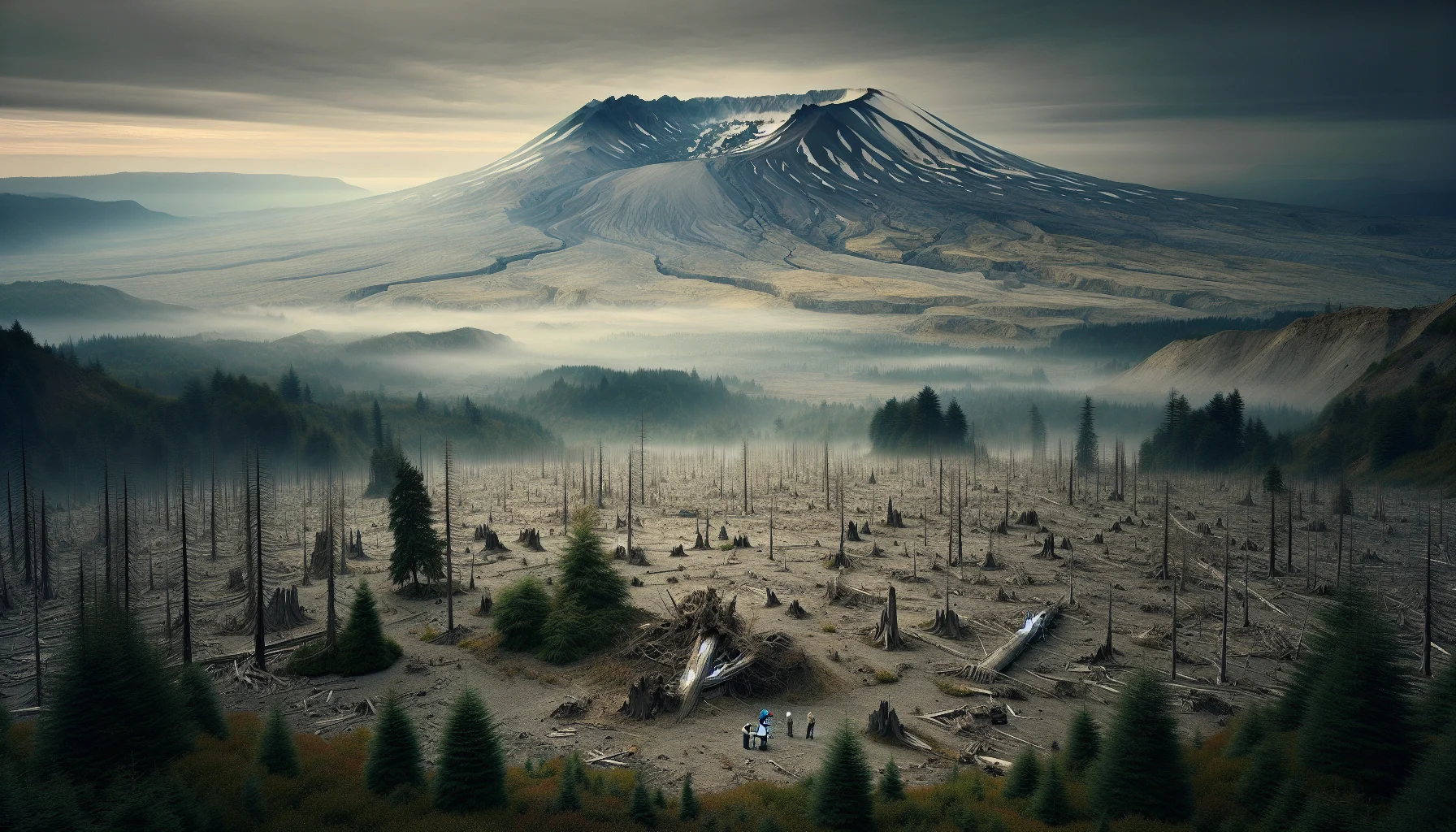
The 1980 Eruption of Mount St. Helens
by: The Calamity Calendar Team
May 18, 1980
Prelude to Destruction
The earth signaled its unrest quietly at first. Deep beneath the snow-covered peak of Mount St. Helens, something ancient and powerful began to stir. By March 20, 1980, the subtle whispers of magma shifting in its subterranean chamber manifested as a sizable 4.2 magnitude earthquake. For a mountain that had slumbered peacefully since its last eruption in 1857, this was a wake-up call both literal and figurative. People in the nearby communities began to grow uneasy, wondering if the mountain, a seemingly benign landmark in Washington’s Cascade Range, was preparing to reclaim its fiery heritage.
The Mountain Awakens
Mount St. Helens was considered just another picturesque peak along the Cascade Range—a range of volcanoes, each with its own history of fiery eruptions. Yet, for over a century, she had remained silent. That changed when, just a week after the seismic activity began, a dramatic explosion ripped from its summit on March 27, 1980. It wasn’t a full-scale eruption but a smoke signal to all who were watching. The steam venting was relentless, and it was only the beginning. With each release, the north slope of the volcano began to bulge ominously, growing outward by up to five feet daily. This strange, outward swelling indicated immense pressures building within—the harbinger of something no one had ever seen.
The Catastrophic Day
May 18, 1980, dawned like any other spring day, the peace of a Sunday morning draping the Pacific Northwest. But at 8:32 AM, tranquility shattered. A magnitude 5.1 earthquake rocked the mountain with such ferocity that it triggered the collapse of the entire north face in what became the largest landslide recorded in human history. This monumental shift unleashed the beast within Mount St. Helens.
Immediately following the landslide, a lateral blast, traveling at supersonic speeds, tore through the remaining structure of the mountain. For the residents nearby, there was no time to react. The force obliterated everything in its path, leveling 230 square miles of forest with the raw, indifferent intensity of nature's rage. In an instant, life and landscape were irrevocably altered.
Air Darkens, Hearts Sink
As the lateral blast quieted, the ash began its insidious journey across the sky. By the afternoon, the light of day was obscured across the region, as densely packed ash clouds drifted east, cloaking cities and towns in darkness. This ash became a relentless reminder of the eruption's power, spreading over 11 states, halting air travel, and choking otherwise vibrant landscapes into silence. Entire communities found themselves blanketed under the heavy, gray silt that refused to settle—a testament to the distant roar of Mount St. Helens’ fury.
The human toll of the eruption echoed through the lives of families and communities. Fifty-seven souls were lost, swept away by the force of nature. Amongst them were scientists, photographers, and local residents, whose stories were engulfed in the ashes of that morning. Entire homes were reduced to rubble, and livelihoods destroyed as forests were flattened, and rivers shifted course, their waters now a murky path choked with ash and debris.
Thanks for subscribing!
Picking Up the Pieces
The immediate aftermath required a monumental effort to coordinate response and recovery. Local and federal agencies, from the National Guard to scientific teams, mobilized to combat the destruction. Roads had to be cleared, ash removed, and rivers dredged to prevent catastrophic flooding from the massive debris. Communities were slowly rebuilt, infrastructure restored, and the arduous task of cleaning the heavy ash from cities began.
Economically, the impact was staggering—forests that once supported robust logging industries were gone, leaving behind a barren wasteland. The eruption ravaged not only landscapes but also the economy, with damages climbing past a billion dollars, its aftershocks felt long after the skies had cleared.
Lessons Learned
From the chaos rose new understandings, both scientific and societal. The eruption of Mount St. Helens dramatically changed volcanic research, particularly the study of lateral blasts, phenomena previously underestimated in the science community. The lessons learned from the tragedy led to advances in monitoring and early warning systems, ensuring communities could be better prepared should another sleeping giant decide to wake.
Today, Mount St. Helens stands as both a memorial and a living laboratory. Since the eruption, the United States Geological Survey has monitored the site with cutting-edge technology, striving to ensure that the stories etched in ash and stone remain a guidepost for future generations.
Nature’s Return
In the years since, the landscape around Mount St. Helens has borne witness to nature’s resilience. Though the north face bears a scar from that fateful day, life has quietly begun to reclaim what was lost. An expanse of once-flattened trees now sees new saplings reaching skyward, defying the odds. Visitors and scientists alike walk the land, not forgetting the past, but witnessing the beginning of an ongoing story—a tale of destruction, recovery, and the enduring power of nature.
Thus, Mount St. Helens reminds us of the beauty and the terror that lies within our planet, urging both caution and respect for these ancient, slumbering sentinels of the Earth.
Stay in the Loop!
Become a Calamity Insider and get exclusive Calamity Calendar updates delivered straight to your inbox.
Thanks! You're now subscribed.